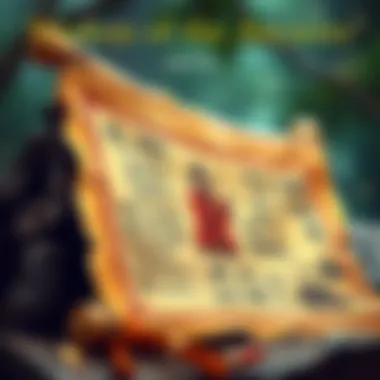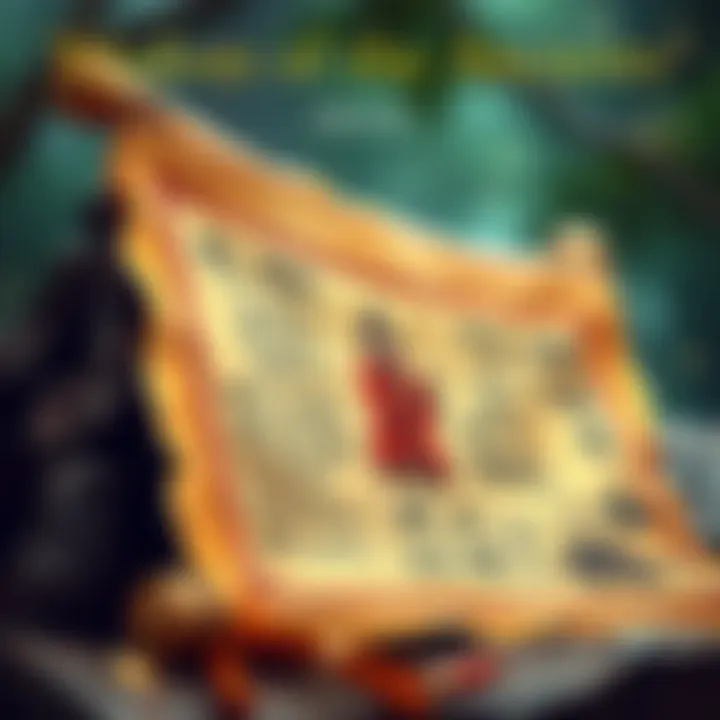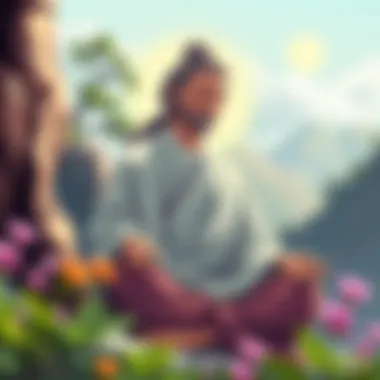Exploring the Depths of Tao Te Ching Today


Intro
The Tao Te Ching is an ageless text embraced by many, yet often it feels like a foreign language in our fast-paced contemporary society. It's like finding a rare gem in a cluttered attic. This sacred book, attributed to Laozi, offers profound insights into life, balance, and our connection to the universe. It stands tall amidst countless self-help books and philosophical works, leaving readers stirred and reflective.
In this exploration, we seek to bridge the ancient wisdom of the Tao Te Ching with today’s world. It's not merely about summarizing its teachings; we aim to understand how they resonate in our daily experiences and influence our paths towards self-discovery. For students, professionals, and avid readers alike, this discourse aims to reveal how the teachings can be woven into the fabric of modern life.
As we unravel the layers, you’ll encounter key themes that transcend time, from the concept of wu wei (effortless action) to the principle of embracing simplicity, underscoring their importance in our complicated lives. By the end of our journey, we’ll not only appreciate the depth of the text but also gain practical tools to apply its wisdom in a world that often feels hectic and overwhelming.
Let’s embark on this enlightening adventure together, drawing connections that illuminate the relevance of Taoist philosophy today.
Prelims to Tao Te Ching
The Tao Te Ching stands as one of the cornerstones of Eastern philosophy, offering insight not just into the philosophical thought of ancient China, but also into the broader human experience. When we delve into the text, we encounter a world rich with paradox, simplicity, and profound wisdom. This introduction discusses the significance of the Tao Te Ching, emphasizing how its principles resonate with modern challenges and our continuous quest for understanding life’s complexities.
Historical Context of the Text
To grasp the depth of the Tao Te Ching, one must first consider the historical milieu in which it emerged. Written around the 6th century BCE, the text is attributed to Laozi, a figure wrapped in myth and reality. During this time, China was in a state of flux, experiencing political turmoil and social strife. Confucianism and various schools of thought were vying for influence. The Tao Te Ching provided a counterpoint, advocating for harmony, balance, and a return to natural order.
The text itself is believed to have been compiled from oral traditions, embodying teachings that predate even Laozi. It reflects a society grappling with moral decay, urging people to seek a path (the Tao) that promotes well-being and collective peace. Recognizing the intricate relationship between the text and its socio-political context lends richness to its interpretations today.
Author and Authenticity
As for authorship, the legitimacy of Laozi as the author of the Tao Te Ching leaves room for debate. Scholars note that the text's compilation likely involves contributions from various thinkers. A notable point here is that whether Laozi was indeed a single individual or a collective representation does not dilute the message.
His portrayal emphasizes humility, wisdom, and the value of the natural world. The Tao Te Ching invites readers to explore the depth of their inner selves, transcending cultural and temporal boundaries. The quest for authenticity in the text remains relevant, illustrating the timeless nature of its core teachings. The essence of the philosophy extends beyond names and dates, appealing to timeless wisdom that resonates throughout the ages.
As we continue our exploration, we will see how these historical layers not only shape the understanding of the text but also inform its application in personal growth and social dynamics today.
Core Concepts of Taoist Philosophy
Taoist philosophy, primarily found in the Tao Te Ching, offers intricate insights into the nature of existence. It serves as a philosophical blueprint, not just for ancient Chinese society but for modern individuals seeking balance and harmony in life. This section examines fundamental ideas that encapsulate Taoist thought, revealing their significance in today’s context.
The Nature of the Tao
At the heart of Taoism lies the concept of the Tao, an often indefinable notion that denotes the ultimate principle of the universe. It can be likened to an ever-flowing river—sometimes calm, sometimes turbulent—but always moving. The Tao is the source of all things, encompassing both the seen and unseen, the active and passive. When we ponder the nature of the Tao, it’s crucial to understand that it transcends human thought and language.
"The Tao that can be told is not the eternal Tao."
This saying encapsulates the paradoxical nature of the Tao. As we navigate life, recognizing that our attempts to define or control it can often lead to frustration is part of its wisdom. The importance of realizing our connection with the Tao lies in our ability to find serenity in uncertainty. Embracing the unexplainable helps ground oneself in an ever-changing world.
Wu Wei: The Principle of Non-Action
Wu Wei, often translated as "non-action," is a principle that stands in stark contrast to the busy, achievement-oriented mindset prevalent today. It suggests that true effectiveness comes not from battling against the currents of life but from aligning with them. It’s about knowing when to act and when to let things unfold naturally.
In practical terms, implementing Wu Wei can help mitigate stress and promote a sense of ease. For instance, consider the difference between a person who forces a project to completion versus one who allows creativity to flow naturally. The latter often finds that solutions emerge more organically, as if the right circumstances align effortlessly.
Recognizing when to practice Wu Wei can lead to greater personal well-being. It trains us to listen to our intuition and trust in a process that is often bigger than ourselves.
Yin and Yang: The Balance of Opposites
Yin and Yang is another fundamental aspect of Taoist thought, revolving around the idea of dualities and their interplay. This concept illustrates how seemingly opposing forces can complement one another. Think of it like day and night—one cannot exist without the other, and both are essential for the natural cycle of life.
Understanding Yin and Yang is key to achieving balance. In one’s personal life, it means accepting both strengths and weaknesses, light and dark emotions, and understanding that they co-exist. By fostering a deeper awareness of this balance, individuals can cultivate harmony within themselves.
- Yin: Represents receptivity, intuition, and darkness.
- Yang: Embodies assertiveness, logic, and light.
When these forces are out of sync, it can lead to turmoil. A keen insight derived from this balance can aid in resolving conflicts, whether it's within ourselves or among others.


Tao Te Ching as a Guide to Personal Growth
The Tao Te Ching, a foundational text of Taoist philosophy, serves as a profound guide to personal growth, emphasizing the importance of aligning oneself with the flow of life rather than resisting it. In today’s chaotic world, this ancient wisdom can be the beacon that guides individuals toward a more fulfilling existence. The teachings within this text encourage self-exploration, reflection, and an understanding of one’s place in the grand scheme of life. Furthermore, they promote the idea that growth does not necessarily come from forceful action but through understanding and accepting the natural order of things.
Through its verses, the Tao Te Ching offers insights on cultivating a deeper connection with ourselves and our surroundings. This connection can catalyze personal transformation, which is vital in an era marked by rapid change and external pressures. For anyone seeking clarity amid the noise, the principles found in this text can illuminate the path to genuine fulfillment.
Self-Awareness and Reflection
At the heart of the Tao Te Ching is the concept of self-awareness. This idea permeates the text, presenting the notion that understanding oneself is the first step towards true growth. Self-awareness invites introspection, allowing individuals to confront their thoughts, emotions, and innate desires.
By engaging in regular reflection, one can recognize patterns in behavior that may either nurture or hinder their personal development. The Tao Te Ching encourages practitioners to pause and consider their actions rather than plunge into rash decisions. This mindful contemplation helps in uncovering the "Tao" or the way, leading to a harmonious life.
Reflecting through journaling or meditation, individuals can align their values with their actions. This practice not only builds stronger self-identity but also lays the groundwork for resilience against life’s challenges.
"Knowing others is intelligence; knowing yourself is true wisdom. Mastering others is strength; mastering yourself is true power."
— Laozi
Recognizing Inner Strengths
Another pivotal aspect of personal growth highlighted in the Tao Te Ching is the ability to recognize and harness inner strengths. Instead of focusing solely on external accolades or societal measures of success, the text invites readers to explore innate talents and qualities that reside within.
Finding strength in vulnerability is a theme that resonates throughout the teachings. By owning one’s struggles and acknowledging what one might view as weaknesses, individuals can uncover their true power. Everyone has a unique set of skills and perspectives; recognizing these can be a game-changer in personal and professional realms.
Adopting a mindset that celebrates inadequacies as growth opportunities lays the foundation for a more profound sense of self-worth and purpose. The Tao Te Ching posits that real strength is not about dominating others, but about nurturing compassion and understanding oneself deeply.
In summary, the Tao Te Ching serves as not just a philosophical treatise but as a practical manual for personal growth. Through self-awareness and recognizing inner strengths, readers can cultivate a richer, more grounded existence, one that reflects the true essence of their being.
The Importance of Simplicity
Simplicity stands as a cornerstone in the philosophy of the Tao Te Ching, and understanding this principle is vital for grasping its overarching teachings. In a whirlwind world filled with distractions and complexities, the wisdom of simplicity shines with clarity. It suggests a return to the basics, advocating for a life uncluttered by excess—be it thoughts, possessions, or ambitions. The implications of embracing simplicity are not only profound for personal development but also for a broader societal impact.
This principle resonates with various benefits. Firstly, it fosters mental clarity. By stripping away the unnecessary, individuals can focus on what truly matters. This clearing of mental fog allows for better decision-making and enhances emotional well-being. Moreover, simplicity encourages deeper connections with people and nature since it compels us to slow down and appreciate our surroundings. In turn, this deeper connection can lead to a more fulfilling and meaningful life.
Additionally, the Tao Te Ching teaches that embracing simplicity leads to a sense of harmony with the universe. Instead of constantly striving for more, which often induces stress and dissatisfaction, a simpler life invites a peaceful acceptance of the present moment. Through simplicity, we can cultivate a sense of contentment with what we have, allowing us to appreciate the beauty of life as it unfolds.
Living a Minimalist Lifestyle
Living a minimalist lifestyle is a direct application of the Taoist principle of simplicity. This approach does not merely indicate a reduction of physical belongings; it symbolizes a comprehensive shift in perspective. Minimalism entails evaluating what you truly need, leading to intentional choices that reflect personal values rather than societal pressures.
Imagine a home filled with items that serve a purpose or hold sentimental value. Each object tells a story and adds meaning to life. Contracy, consider a space cluttered with things acquired out of fleeting desire or social expectation. The latter often brings anxiety and a sense of being overwhelmed rather than joy.
In practical terms, minimalism might begin with evaluating belongings; choosing to keep only those that add value. The process can be cathartic—donating old clothes, discarding gadgets that no longer serve a need, or even reshaping daily habits to prioritize experiences over possessions. As one embraces minimalist ethics, they often realize that deeper happiness arises not from having it all, but from savoring the essence of life itself.
Avoiding Materialism in Modern Life
In today's fast-paced society, the lure of materialism can be insidious. Advertisements bombard us daily, convincing individuals that happiness is intertwined with acquisition. However, by integrating the simplicity advocated by the Tao Te Ching, we can actively resist these materialistic temptations.
The heart of this resistance lies in self-awareness. Recognizing the fleeting nature of possessions is crucial to sidestepping the trap of consumerism. Reflecting on what truly energizes us—meaningful relationships, personal growth, moments spent in nature—can reorient one’s values. When individuals prioritize experiences and connections over material goods, they often find more lasting satisfaction.
Furthermore, engaging with community initiatives or local craft markets can redirect focus toward supporting artisans and sustainable practices, fostering a sense of connection and purpose that eclipses the superficial appeal of mass-produced goods.
"Simplicity, patience, compassion. These three are your greatest treasures." - Lao Tzu
As we peel away layers of complexity, we might find profound truths waiting in the shadows, eager to reveal themselves.
Tao Te Ching and Leadership
In today's fast-paced world, the concept of leadership has evolved significantly. Many people are searching for more than just control; they seek wisdom that nurtures genuine connection and inspires growth. The teachings of the Tao Te Ching have surfaced as a rich resource for those longing to step away from conventional leadership styles marked by authority and competition. Instead, the focus here is on harmonious collaboration and the cultivation of servant leadership.
The Taoist Approach to Leadership


Taoist principles offer an alternative perspective on leadership that resonates with a variety of contexts—from corporate offices to community organizations. This approach pivots around a profound understanding of balance and adaptability. Unlike traditional models that promote rigidity, the Taoist approach embraces flexibility in thought and action. It underscores the importance of listening and observing, fostering an environment where leaders can respond to circumstances with a more nuanced touch.
Consider the metaphor of the water in the Tao Te Ching: soft yet unyielding, it finds a way around obstacles rather than attempting to overpower them. This signifies that the best leaders are not those who dictate from the front, but those who flow with their teams. In light of this, the leaders who embody the principles of wu wei, or effortless action, navigate their roles without forcing outcomes; they cultivate relationships where trust and support blossom.
Empowerment through Servitude
An essential tenet of the Tao Te Ching is the notion that true power comes from the ability to serve others. This outlook challenges the typical image of a traditional leader, promoting the idea that by lifting others, leaders are elevated in their roles. When a leader practices humility and service, it builds a robust framework for collaboration and innovation.
Leadership through servitude is a practice that encourages leaders to view their responsibilities not as burdens, but as opportunities to empower those around them. Take for instance, a manager who prioritizes the well-being of their team. By doing so, they create an atmosphere where employees feel valued and motivated to contribute their best efforts. This is not simply a heartwarming idea; research shows that organizations that embrace servant leadership see improved team engagement and productivity.
As Laozi suggested, "The best way to lead is to be a model for others to follow." Fostering a culture rooted in servanthood helps dismantle hierarchical barriers and invites diverse perspectives into the dialogue. Instead of enforcing decisions, leaders who embrace this philosophy elicit input and drive a sense of shared ownership, ultimately leading to collective success.
"To lead is to serve; to serve is to lead. As the river nourishes the land without distinction, a good leader nurtures all that they touch."
In summary, the teachings found within the Tao Te Ching emphasize a profound and transformative understanding of leadership. By integrating these principles into modern contexts, leaders can create environments rich in empathy, collaboration, and empowerment.
Modern Interpretations of Tao Te Ching
In the ever-evolving landscape of contemporary thought, the Tao Te Ching remains a beacon of wisdom and insight. Its ancient precepts, while steeped in history, have been woven into the fabric of modern interpretations, making the text relevant for today’s challenges and aspirations. The intersection of traditional Taoism with modern ideas presents a fertile ground for intellectual exploration, offering fresh perspectives on personal growth, leadership, and the nature of existence. By delving into these fresh interpretations, one can uncover myriad ways this ancient text illuminates the path to self-awareness and balance in a chaotic world.
Contemporary Adaptations in Literature
Literature often serves as a mirror reflecting societal values and individual dilemmas. Numerous authors have incorporated themes from the Tao Te Ching into their works, creating narratives that resonate with the notion of harmony, simplicity, and the ebb and flow of life. For instance, writers like Alan Watts and Jiddu Krishnamurti have drawn directly from Taoist concepts to challenge traditional Western paradigms.
One notable adaptation is found in The Tao of Pooh by Benjamin Hoff. By using whimsical illustrations and the character of Winnie-the-Pooh, Hoff elucidates the timeless principles of Taoism in a way that's accessible to all ages. This charming approach familiarizes readers with the essence of Wu Wei—non-action, or effortless action—without the heavy burden of dense philosophical jargon.
- Benefits of these adaptations include:
- Clarity: Making complex ideas approachable.
- Engagement: Storytelling enables emotional resonance, compelling readers to reflect.
- Relevance: Addressing modern life’s intricate challenges with timeless wisdom.
Furthermore, contemporary poetry and prose often echo the Tao Te Ching's call for authenticity and a deep connection to nature. Writers effortlessly intertwine these ancient tropes with modern dilemmas, encouraging readers to cultivate mindfulness in an age dominated by digital distractions.
Application in Psychotherapy
In the realm of psychology, the principles of the Tao Te Ching have found a foothold as therapeutic tools. Integrating Taoist concepts into psychotherapy offers unique pathways for self-exploration and healing. Therapists often adopt Taoist ideas to guide clients through their personal struggles, emphasizing acceptance, mindfulness, and the natural flow of life.
One significant approach is through Mindfulness-Based Stress Reduction (MBSR), which incorporates aspects of Taoist philosophy. By encouraging individuals to observe their thoughts and feelings without judgment, MBSR mirrors the Tao Te Ching's principle of accepting things as they are, gently nudging clients toward a greater understanding of their inner selves.
Psychotherapists might also emphasize the idea of balance from the Yin and Yang concept, helping clients identify and embrace opposing forces within themselves. This approach fosters a sense of wholeness, enabling individuals to navigate their lives with a sense of purpose and direction.
"The Tao is the source of all things, and it is in the harmony of polar opposites that true understanding lies."
- Applications in therapy can lead to:
- Enhanced self-acceptance: Recognizing imperfections is a key tenet to personal growth.
- Resilience: Understanding the transient nature of emotions can foster emotional stability.
- Clarity: Gaining insight into one's life purpose by aligning with life's natural flow.
By exploring the contemporary adaptations in literature and the therapeutic applications of the Tao Te Ching, we not only see its relevance shine in our current age but also appreciate the transformative power it holds in guiding individuals toward enlightenment and harmony.
Challenges in Understanding Tao Te Ching
Understanding the Tao Te Ching can be like trying to catch smoke with your bare hands. Its ancient verses, rich with imagery and layered meanings, navigate cultural and linguistic terrains that can stump even the most diligent reader. Recognizing these challenges is crucial for anyone looking to truly grasp the depth of its teachings. Misinterpretations and barriers can distort the essence of your inquiry into this seminal text, making it vital to approach it with care and an open mind.
Linguistic and Cultural Barriers
The Tao Te Ching is ensconced in the cultural fabric of ancient China. Written in classical Chinese, the Tao Te Ching employs words that may carry multiple meanings, influenced by the historical and philosophical context of its time. For instance, the character "Tao" encapsulates notions of a path, a way of life, or the fundamental principle that underlies the universe. This complexity can present a hurdle for modern readers, as they may grapple with translations that differ widely in their interpretation.
Moreover, the cultural nuances embedded within the text can easily be misread. Concepts like Wu Wei (non-action) and the complementary forces of Yin and Yang have deep philosophical roots in Eastern thought that are often absent or misrepresented in Western perspectives. Bridging this gap requires not just a translation, but an understanding of the social and historical contexts that shaped these ideas.
For instance, when Lao Tzu talks about simplicity, this doesn't merely mean living with fewer possessions; it speaks to a broader philosophy regarding one's attitude toward life. To appreciate this sentiment, one must go beyond surface reading and engage with the deeper ethical questions that challenge modern views on success and contentment.


"If you want to awaken all of humanity, then awaken all of yourself; if you want to eliminate the suffering of the world, then eliminate all that's dark and negative in yourself." – Lao Tzu
Misconceptions and Misinterpretations
Another hurdle is the plethora of misconceptions that have arisen over the years surrounding the Tao Te Ching. One common misinterpretation is that Taoism encourages passivity or inaction in life. However, as Wu Wei suggests, it's not about being idle; rather, it means aligning yourself harmoniously with the natural flow of life, making deliberate choices that resonate with one's true self.
Additionally, many readers equate the philosophies of Taoism directly with other spiritual beliefs, often misunderstanding its unique stance. There's a tendency to oversimplify the text, reducing it to self-help jargon or spiritual platitudes, which undermines the profundity of its teachings. For example, the idea of Yin and Yang is often taken at face value when, in reality, it reflects a complex interplay of interdependence and balance that reaches into various aspects of existence.
To navigate these misunderstandings, one must engage critically with the text. Reflecting on its verses, discussing interpretations in study groups, or exploring commentaries from various scholars can help elucidate its true meaning. Moreover, examining the Tao Te Ching from different perspectives—philosophical, psychological, and even artistic—can enhance comprehension.
Practicing Taoist Principles
Practicing Taoist principles offers a distinct framework for understanding one's existence, aligning with natural rhythms, and fostering a deeper connection with oneself and the environment. In a world that often prioritizes speed and material success, integrating these philosophies can lead to a profound transformation in the everyday life of individuals. The essence of Taoism lies in its call to live authentically and harmoniously, and this requires not just comprehension, but also the consistent application of its teachings.
Integrating Taoism into Daily Life
To bring Taoist principles to the forefront of daily routines, one must first cultivate an awareness of the inherent flow of life. It's not about radical changes overnight, but rather, subtle adjustments that align actions with the values embodied in the Tao Te Ching. Here are some practical approaches to integrating these principles:
- Embrace natural rhythms: Rise with the sun, allow the day's natural progression to dictate your actions, and engage in activities that resonate positively with your internal clock. It’s in recognizing these cycles that one can truly find peace.
- Simplify decisions: Instead of overcomplicating choices, adopt a mindset of wu wei, or effortless action. Balance can often be found when decisions stem from a place of calm rather than stress. This means letting go of the need to control every aspect of life.
- Practice stillness: Incorporate quiet moments into your day, be it through meditation, nature walks, or simply sitting in silence. These pauses allow for reflection and connection to the Tao.
Furthermore, the discipline of journaling can be a handy tool. By jotting down daily experiences and reflections, one can cultivate a better understanding of how principles are being applied. Over time, patterns emerge that reveal insights on personal growth and alignment with the Tao.
Mindfulness and the Taoist Perspective
Mindfulness, a concept that has gained traction in modern lifestyles, is deeply rooted in Taoist philosophy. Practicing mindfulness from a Taoist perspective encourages a heightened awareness of the present moment, fostering acceptance and appreciation for the simple joys of life.
Here are some key elements to consider:
- Focus on the present: Taoism urges individuals to stop dwelling on the past or excessively worrying about the future. This mirrors the concept of mindfulness, prompting one to savor each moment.
- Cultivate acceptance: Recognize the impermanence of life and accept events as they come. This acceptance reduces resistance, creating space for peace and tranquility.
- Engage fully with nature: The Tao Te Ching frequently highlights nature as a guide for living. Spend time outdoors, breathe in the fresh air, and notice the interconnectedness of all things. This practice not only grounds you but allows for a richer understanding of Tao.
"He who knows does not speak. He who speaks does not know." This quote resonates profoundly with the idea of mindfulness—recognizing that sometimes, silence breeds wisdom.
By adopting these practices, individuals can nurture a deeper connection with their inner selves and the world around them. It’s not merely about following a set of rules, but about creating a lifestyle that honors the teachings of the Tao, paving the way for peace, growth, and authentic existence.
Feel free to visit the following resources for further exploration:
Closure: The Enduring Legacy of Tao Te Ching
The Tao Te Ching's significant impact on philosophy, spirituality, and personal development endures through the ages. With its age-old wisdom, the text provides a lens through which to view the complexities of life, nourishing our minds and spirits. Readers and practitioners continue to find practical guidance within its pages, as its teachings resonate far beyond their historical context.
One aspect of the text's legacy is its ability to promote balance and harmony. The concepts of yin and yang, as well as the notion of Wu Wei or effortless action, encourage a mindful approach to existence. In a world characterized by chaos and fast-paced living, the philosophy of Taoism serves as a calming antidote, reminding individuals of the importance of aligning themselves with the natural rhythms of life.
In the twenty-first century, the Tao Te Ching remains relevant. It offers fresh perspectives on self-awareness and personal growth, impacting many spheres of life, including leadership, relationships, and mental health. modern thinkers apply its principles to guide their decisions and actions, subtly shifting the landscape of contemporary life.
Relevance in the Twenty-First Century
The relevance of the Tao Te Ching in today’s society is striking. Diverse fields are tapping into its insights, with some therapists leveraging its concepts to help clients navigate the intricacies of stress and anxiety. By practicing mindfulness, as suggested by the text, individuals can cultivate a greater sense of peace amid daily pressures.
Moreover, the widespread interest in holistic living and sustainability aligns seamlessly with Taoist principles. As people grapple with ethical dilemmas surrounding consumerism and environmental degradation, the value placed on simplicity and frugality in the Tao Te Ching serves as a guiding framework.
- Mindfulness in the workplace: The application of Taoist principles fosters a more peaceful, cooperative environment.
- Leadership strategies: Many contemporary leaders are finding that adopting a less aggressive, more inclusive approach resonates well with modern teams.
Like a compass pointing towards true north, the teachings of the Tao Te Ching guide many through the fog of modernity.
Inviting Further Exploration
The study of the Tao Te Ching invites ongoing thought and exploration. Each reading can reveal fresh insights, showcasing its timeless quality. Scholars frequently emphasize various interpretations based on their cultural or personal backgrounds. For students and professionals alike, engaging with the text prompts richer discussions and deeper thinking.
In this regard, communities have emerged, where likeminded individuals discuss its principles and share how they implement Taoist concepts in their daily lives. From online forums like reddit.com to local study groups, these platforms extend the conversation and encourage further exploration among seekers.
Furthermore, many writers and artists draw inspiration from the Tao Te Ching, incorporating its wisdom into contemporary forms, enriching the global cultural tapestry. The old text doesn’t merely sit on dusty shelves; it thrives amidst bookshelves and blogs, influencing the creative process continually.
By weaving the teachings of the Tao Te Ching into modern practices, individuals not only honor its legacy but also keep the conversation alive. As we navigate the complexities of contemporary existence, re-examining the Tao Te Ching allows us to gain insight into our paths, savouring its timeless message to live harmoniously with ourselves and the world around us.















